UK coasts
1/90
There's no tags or description
Looks like no tags are added yet.
Name | Mastery | Learn | Test | Matching | Spaced |
|---|
No study sessions yet.
91 Terms
The coast
The meeting point between the land and the sea.
What are the two types of coastal processes?
Marine Processes
Terrestrial processes
Marine processes:
Offshore (water-based)
Terrestrial processes:
Onshore (land-based)
Fetch
The distance over which wind has been blowing, allowing waves to grow in size and energy, before a wave breaks on the shore
Long Fetch
Destructive waves.
Short Fetch
Constructive waves
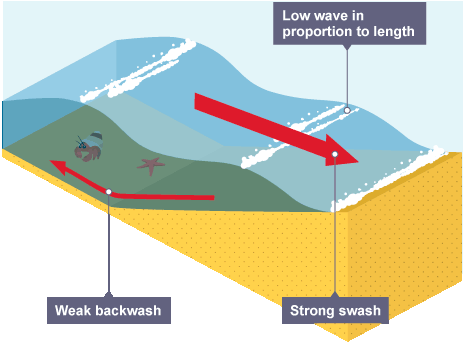
Constructive Waves
Waves which help build up material on the beach. Tend to have a low frequency, strong swash and shallow wave gradient. Stronger swash carries material up onto beach and deposits it there
Constructive wave characteristics:
small waves - low wave height & long wavelength
occur in calm conditions - without much wind
strong swash & weak backwash
the strong swash brings sediment to build up the beach
the backwash is not strong enough to remove the sediment - little material is dragged away
waves are low and further apart
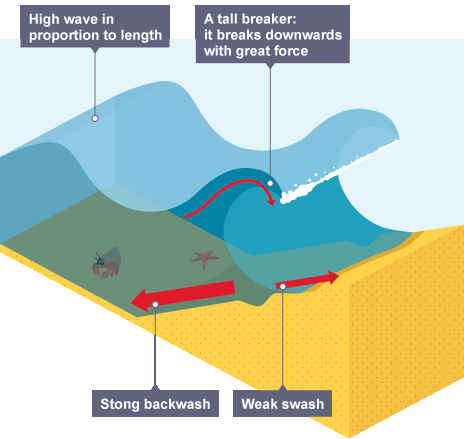
Destructive waves
Waves which remove material from the beach. The swash is weaker than the backwash.
Destructive wave characteristics:
weak swash and strong backwash
occurs in stormy conditions - with strong winds
the strong backwash erodes away sediment/material and transports it away
waves are steep & close together
tall waves with short wavelength
they arrive quickly and have a high frequency - a lot of them come in a short period of time
What does a coastline made up of softer rocks form? Why?
Form low, flat landscapes such as bays and beaches. Because bands of softer rocks (e.g. clay & sand) are eroded quicker by destructive waves.
What does a coastline made up of more resistant, harder rocks form? Why?
Produce rugged landscapes such as headlands. This is because harder rock is more resistant and takes longer to erode.
How are headlands and bays formed?
Occur when there are alternating bands of hard and soft rock running perpendicular to oncoming waves (discordant). First, soft rock is eroded backward - forms inlet. As inlet continues to erode it curves inwards and a bay is formed - usually with a beach. Hard rock is left protruding out to sea as a headland.
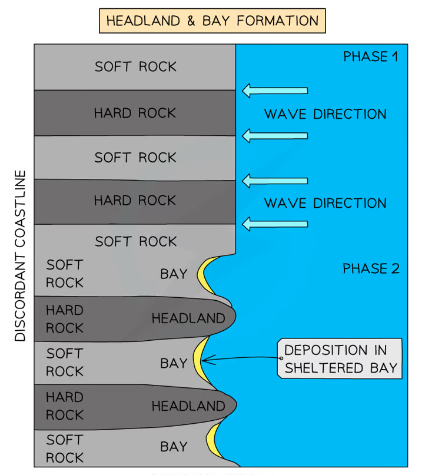
Concordant coastline
Made of the same type of rock and is parallel to the sea. Form coves.
Discordant coastline
Rock type alternates in layers perpendicular to the sea - forming headlands and bays.
What exposes rock to erosion & weathering?
Joints & Faults
Erosion
Displacement of materials by wind, water and ice.
Joint
A small crack in a rock
Fault
A large fracture in a rock.
Attrition
When pieces of rock material are moved by waves and knock into eachother making the material smaller and more rounded.
Abrasion
Occurs on exposed area of rock when sand and small rocks are thrown and scraped against the rock surface by waves.
Hydraulic Action
When large waves break on exposed material they compress air into cracks, when the water falls away the air is released explosively - breaking the rock.
Solution
When seawater (alkaline) dissolves some of the rock minerals in an exposed surface causing the slow breakdown of rock - limestone.
Erosional landforms:
Caves, arches, stacks & stumps
Step 1 - formation of a sea stump (SEA CAVE)
Weaknesses are eroded through HA/abrasion forming a crack/joint, over time the crack widens allowing other forms of erosion to take place (attrition, abrasion, HA, solution). Resulting in a sea cave.
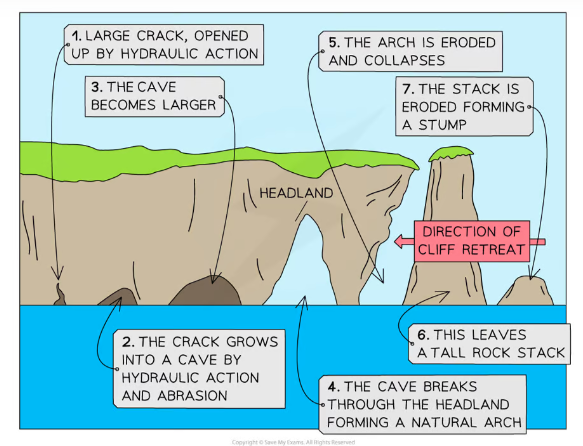
Step 2 - formation of a sea stump (SEA CAVE & ARCH)
Over time the cave widens and deepens forming a sea arch.
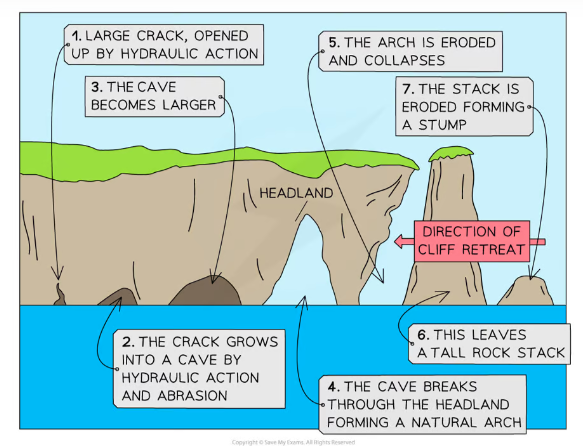
Step 3 - formation of a sea stump (SEA STACK)
The arch will continue to be eroded - attrition - and through weathering processes - freeze thaw weathering - the sides of the arch are attacked breaking it down further. As erosion continues the arch collapses due to gravity, debree is transported away and a retreated cliff and sea stack remains.
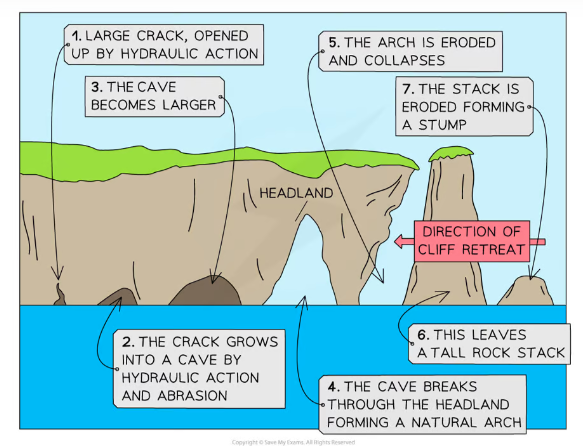
Step 4 - formation of a sea stump (SEA STUMP)
Over time, weathering and erosion continues to break down the sea stack. This occurs fastest at the base of the sea stack due to waterlevel - undercutting. The structure is weakened and eventually collapses leaving a sea stump that is visible at low tide.
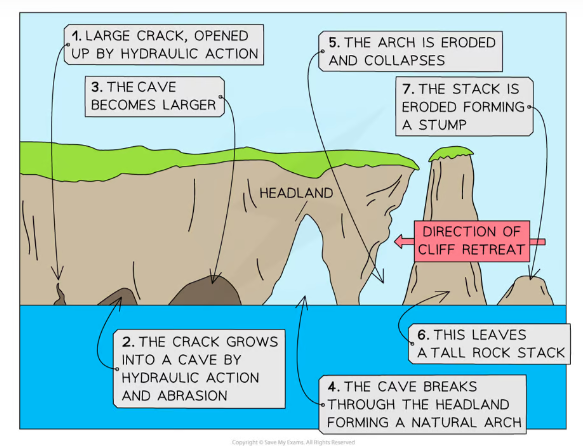
How are cliffs formed? Slope vs Steep cliff.
Shaped through erosion and weathering processes. Soft rock erodes quickly and will form sloping cliff faces. Whereas, steep cliffs are formed when there is hard rock facing the sea.
What is a wave-cut platform?
A wide gently sloping surface found at the foot of a cliff.
How is a wave-cut platform formed?
Sea attacks the base of a cliff between the high and low water mark - forming a wave-cut notch
Abrasion, solution and HA further extend the notch back into the cliff
Undercutting of the cliff leads to instability and collapse of the cliff
Backwash of the waves carries away eroded material - leaving behind wave-cut platform
Process repeats and cliff continues to retreat - leading to coastal retreat.
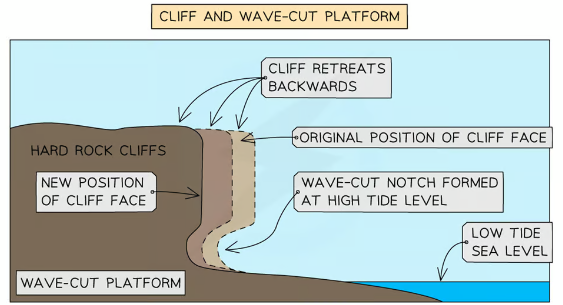
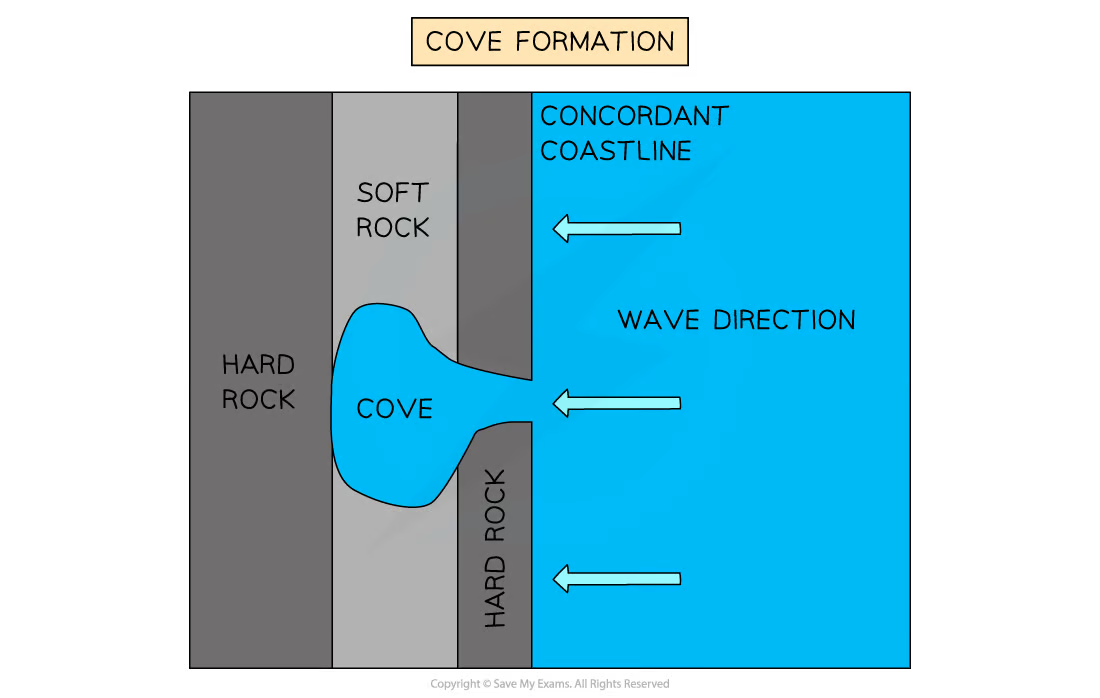
Cove formation:
Hard and soft strata alternates - forming a concordant coastline as one rock type is in contact with the sea. Strata of hard rock will form cliffs
Hard rock cliff face may crack - caused by erosion (HA or abrasion)
Over time hard rock is eroded away. - leaves a narrow channel through hard rock strata, eventually exposing the less resistant rock behind
Less resistant rock erodes faster than hard rock - creates a wide, pool-like structure known as a cove
Erosion continues until the cove has extended to the next strata of hard rock where erosion slows once again. So cove will not progress further inland
Waves will diffract as they pass through the coves narrow opening and into the cove as they can no longer escape - providing enough energy for erosion to continue. Cove continues to widen over time
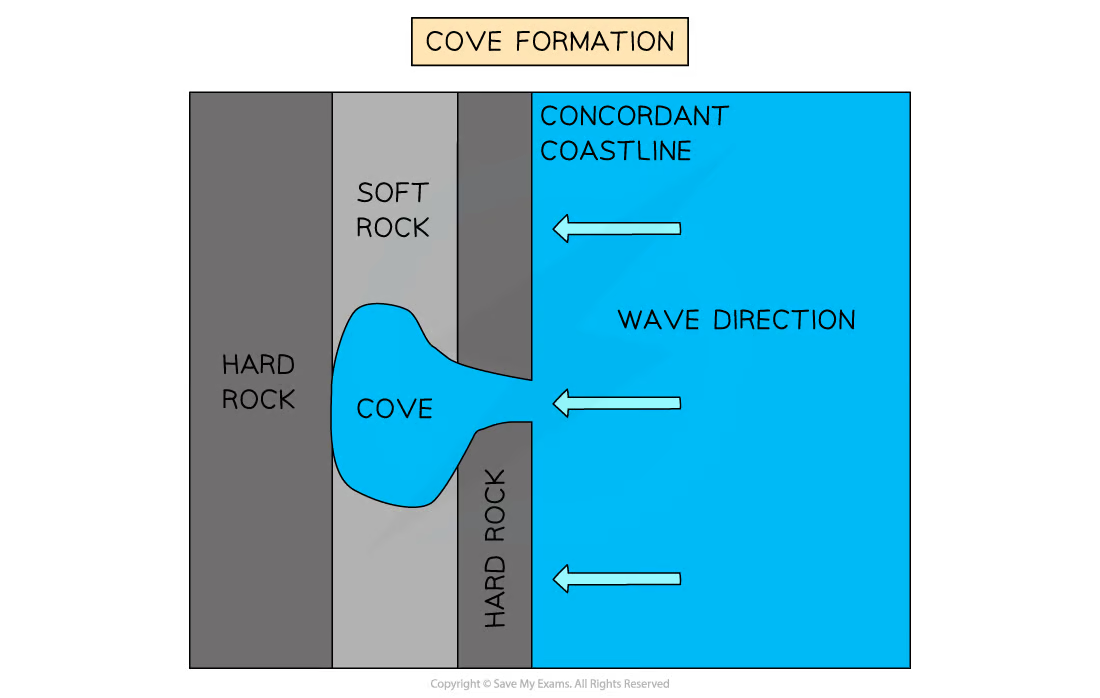
What is the UK’s climate?
Temperate maritime - mild, wet winters and warm, wet summers.
How do seasons affect rate of weathering & erosion?
Cold temperatures lead to freeze-thaw weathering on cliff faces, increasing rock falls. Winds are stronger in winter than summer - stronger winds = increased energy in waves.
Where do prevailing winds come from in the UK? How does it affect weathering?
Come from south-west, brings frequent rainfall and increases rate of weathering.
How does UK climate contribute to coastal erosion?
Climate is a temperate maritime - summers are warm & wet and winters are mild & wet
South-west prevailing winds bring frequent rainfall - leading to increased erosion, weathering and mass movement along the coast
high storm frequency - heavy rainfall & strong winds increase destructive power of waves
during winter UK sees temperatures dip below freezing at night then rise above 0°C by day - repeated freezing & thawing results in weathering of cliff faces and headlands, adding to erosion and cliff collapse.
Where does material in the sea arrive from?
Eroded from cliffs
Transported by LSD
Brought inland from offshore by constructive waves
Carried to coastline by a river
Transportation:
The movement of material across an environment.
What is Longshore Drift (LSD)?
The main process of deposition and transportation along the coast. It is the movement of sediment along the coast in the direction of prevailing wind.
Describe the process of Longshore drift:
Waves approach the beach at an angle (typically <90) due to the prevailing wind
As the waves hit the shore, they carry sediment (e.g. sand & pebbles) up the beach in the direction of prevailing wind
The swash is the water the rushes up the beach after the wave breaks and moves sediment up & along the beach
Once the swash loses energy, the backwash flows back down the beach under the influence of gravity - carrying the material down the beach at right angles
The process of swash & backwash results in a zig-zag movement of sediment along the coast - longshore drift
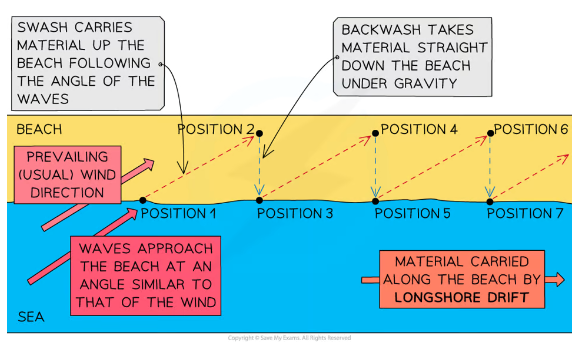
What kind of coastal features can longshore drift lead to?
Groynes, spits and barrier islands.
What are the 4 ways material is moved? Describe them.
Traction - large heavy material (e.g. boulders & pebbles) is dragged along the sea floor/river bed
Saltation - smaller material (e.g. pebble & silt) is bounced along sea floor
Suspension - fine material (e.g. clay & sediment) is held in the water and carried by it
Solution - dissolved material is carried in the water
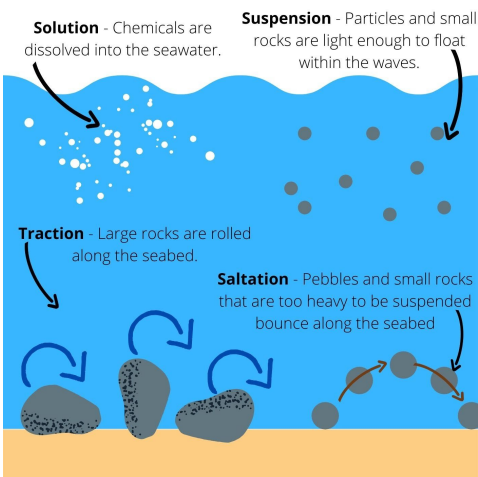
Deposition
The laying down of sediment carried by wind, flowing water, the sea or ice.
When does deposition occur on the coast?
When a wave loses energy so the sediment becomes too heavy to carry. Deposition is a gradual & continuous process - a wave won’t drop all of its sediment at once.
What are beaches?
Large deposits of sand & shingle, are caused by constructive waves (swash stronger than backwash) hitting the coastline.
How are beaches formed?
As constructive waves approach the shore they break & move sand up the beach in the swash. The swash carries the material up the beach at an angle. As the backwash moves back down the beach it loses water & energy as it travels, so the deposition gets progressively smaller - smallest mud settling closer to shore Over time the deposited material builds up, creating various features such as berms, ridges & dunes.
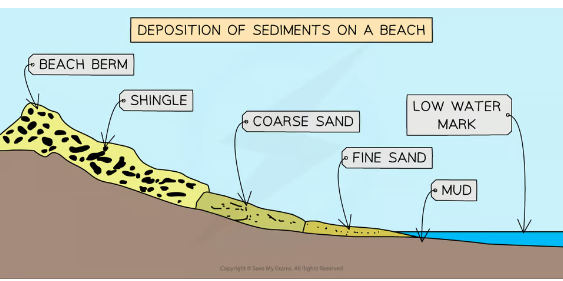
What happens when a destructive wave forms? (what is made on the beach)
Large shingle is thrown above the usual high tide to form a ridge at the top of the beach called a berm.
What is a spit?
A long narrow strip of sand & shingle that is formed due to deposition that projects from the coastline into the sea.
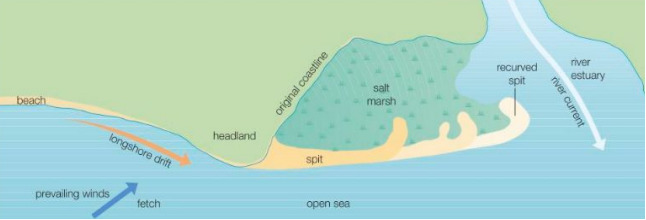
How is a spit formed?
Begins with the process of LSD that moves sediment along the coast. As waves hit the shore at an angle, the swash carries sediment up the beach, and the backwash pulls it back down due to gravity. When the coastline changes direction or current slows down, sediment begins to accumulate and extend outwards - forming a hook. The end of the spit may curve inward due to change in wind direction - forming a spit with a saltmarsh behind it.
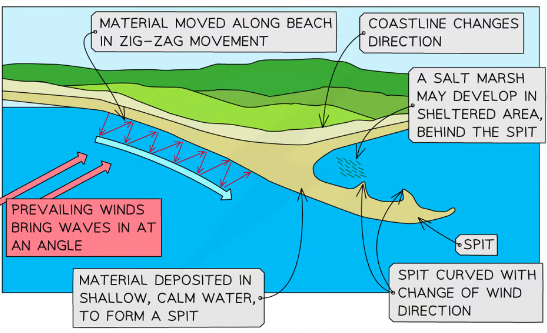
What is a Bar?
Forms when a spit grows across a bay and joins two headlands together.
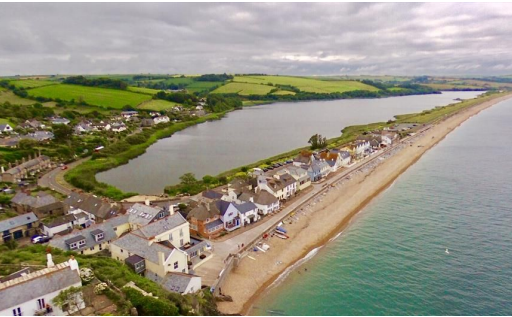
How is a bar formed?
Bars form initially as spits through the process of LSD. LSD continues to grow a spit between two headlands, as there is no current from a river to stop the growth of the spit, LSD connects the two headlands - forming a bar. The area of cutoff land behind the bar is known as a lagoon.
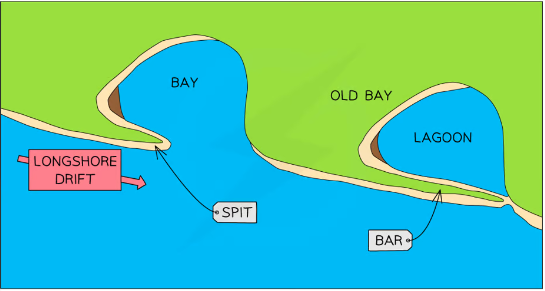
Mass movement:
The downhill movement of material under the influence of gravity.
What does the type of mass movement depend on?
angle of slop/cliff
the rock type (lithology)
the saturation of the ground from previous rain or flooding
Rock falls
Occur on sloped cliffs (over 40° to the beach floor) when the rock becomes exposed to mechanical weathering (often freeze-thaw)
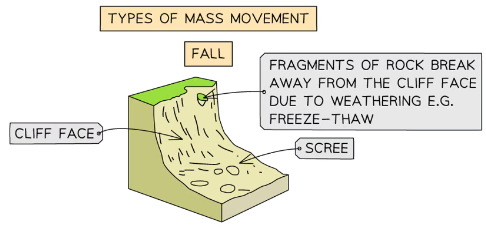
Landslides
Water between the sheets of rock (bedding planes) and the rock face reduces friction allowing large chunks of rock to slide down the cliff.
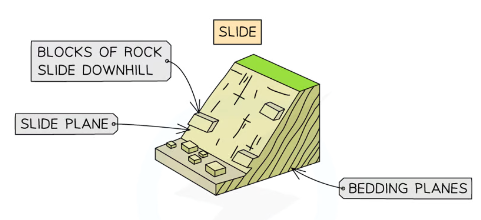
Mudflow
Saturated (waterlogged) soil flows down the face of a hill like a fluid, bulging at the bottom in a lobe
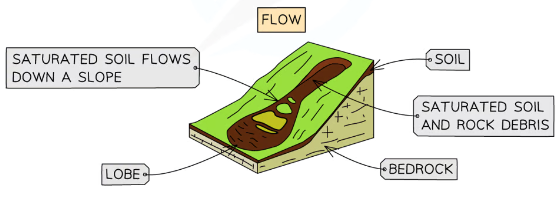
Rotational slip (slump)
Soil and rock fragments become saturated with water, but instead of sprawling down cliff like a mudflow, chunks of rock & soil slip, creating a stepped profile down the cliff face.
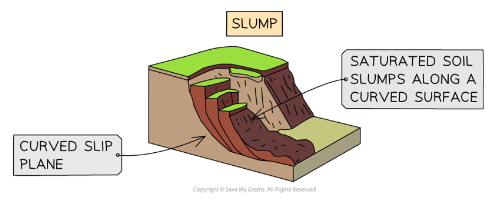
Human activities on the coast:
Housing
Tourism
Business
Agriculture
Industry
Why is housing present in the coast?
natural beauty
quieter lifestyle compared to busy city
Why is tourism present in the coast?
tourist attraction due to beaches, promenades, water sports and sea activities (boating, scuba diving, surfing etc)
good source of income
Why is business present in the coast?
businesses relocate their offices to the coast to avoid high rent prices in the city centre, bringing regular income for locals
Why is agriculture present in the coast?
good water supply & access to water
cheap land
Why is industry present in the coast?
some industry requires a large volume of water during industrial processes
land is cheaper
easy distribution via sea
easy waste disposal
Impacts of development on the coast:
buildings on the coasts increase weight pressure on cliffs
as demand for coastal housing increases, house prices will increase and new housing estates will develop - quiet town will sprawl - losing quiet charm
Tourism leads to increase number of buildings (hotels, campsites attractions), pollution as a result of traffic, litter and waste, however does create income and jobs for local areas
tourism is seasonal - living coastal areas empty for most of year
Impacts of agriculture on coasts:
increased soil erosion
clearance of trees and vegetation can lead to more surface run off and reduced coastal habitats
farmland may be lost due to rising sea levels and coastal erosion
price of land at coast rises, forcing farmers to increase profit with what land they have - adds pressure to land as farmers work more intensively, not letting land rest or rearing too much cattle - tramples vegetation
Impacts of Industry on coasts:
uncommon for industry to be by sea so impact is less than other activities and tends to be indirect
concerns regarding radiation leaks
these sites must be protected from coastal risks as they are of high economic value
Indirect vs direct management
Direct strategies involve physical structures, whereas indirect work with natural processes.
What are factors of coastal flooding?
Storm surges
Storm tides
Tsunamis
Sea level rise
Global warming & climate change
What are storm surges? How do they form?
During a storm, air pressure drops due to the low-pressure environment. When this happens the sea is pulled upwards and forms a storm surge. Storm surges are tall waves that overflow onto land when they reach the coast - causing flooding.
What are Tsunamis?
Large sea waves due to underwater earthquakes, the closer to the coast the bigger the impact.
How does global warming/climate change contribute to coastal flooding/retreat?
Causes sea levels to rise due to increased sea temperatures that cause thermal expansion - putting low-lying coastal areas at increased risk of flooding
Increasing the frequency and intensity of meteorological events (storms, hurricanes, low pressure systems)
increase in coastal flooding
increases height & strength of waves, erosion, weathering and mass movement
erosion increase adds to coastal retreat and risk of further cliff collapse
Impacts of increased coastal flooding:
Coastal settlers migrate elsewhere as it is too risky to live in their coastal environment.
Building more defences against storm surges & rising tides
flooding of roads and damage to railways make travel difficult and are expensive to repair
Managed retreat
Allowing erosion rates to continue unchanged, but instead monitor the rates and try to adapt in future. Popular for local councils as soft/hard engineering can be too expensive.
Coastal prevention actions:
Flood defences
Emergency shelters - on higher ground
Early warning systems - allows for evacuation
Education - inform locals on what to do
Planning - plan new development away from high-risk areas, elevated/flood proof buildings
Buffer zones - areas of land allowed to flood before reaching settlements
Hard engineering:
Use of man-made artificial structures to reduce or halt erosion. Are often very effective at preventing erosion, but are expensive and have significant environmental impacts.
Soft engineering:
Uses more natural materials to reduce erosion, in a more environmentally friendly way. Aims to complement physical environment (unlike hard engineering), use natural coastal defence methods.
Types of soft engineering defences:
Dune stabilisation & Beach nourishment.
What is dune stabilisation?
Maram grass is planted and the roots help bind the dunes, protecting land behind. Sand acts as a barrier between land and sea. Fences can also be put in place to catch the wind too - reduce wind erosion.
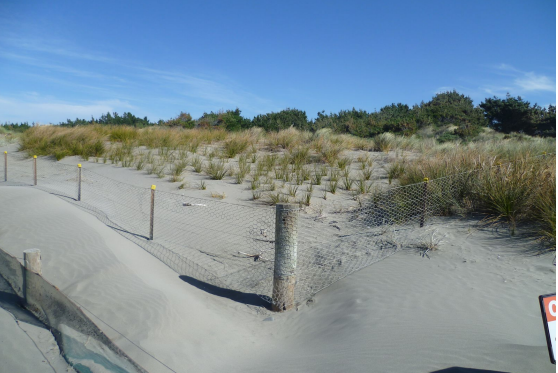
Dune stabilisation pros & cons:
👍cost effective
👍creates an important wildlife habitat
👍minimum impact on natural environment
👎planting can be time consuming
👎can be easily damaged during storm
👎harder to protect larger areas of coastline cliffs
What is beach nourishment?
Sand is added to the beach to replace material lost through erosion & transportation.
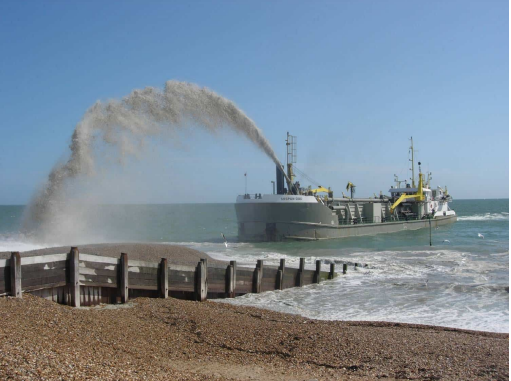
Beach nourishment pros & cons:
👍maintain the beach which is a major tourist attraction
👍blends in with the rest of the beach - not unattractive
👎large quantities of sand needed on a regular basis - expensive
👎process of sand collecting can be disruptive or pollution
What are groynes?
Timber or rock protrusions that trap sediment from LSD.
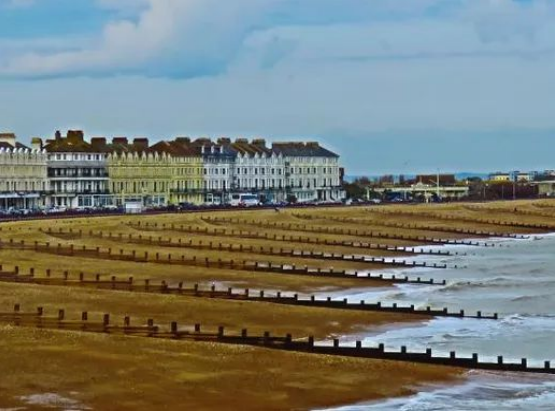
Groynes pros & cons:
👍Builds up beach, protecting cliff & increasing tourism potential
👍Cost effective
👎Visually unappealling
👎Deprives areas downwind of sediment increasing erosion elsewhere
What are sea walls?
Concrete structures that absorb and reflect wave energy, with curved surface
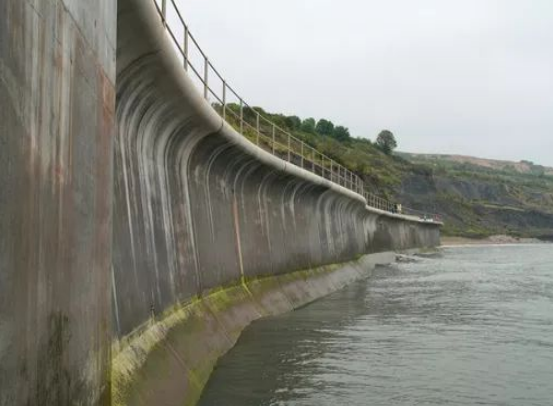
Sea walls pros & cons:
👍Effective erosion prevention
👍Promenade created from it has tourism benefits
👎Can be visually unappealing
👎Expensive to construct & maintain
👎Wave energy is reflected elsewhere, increasing erosion in other areas
What is rock armour(rip rap)?
Large rocks that reduce wave energy, but allow water to flow through.
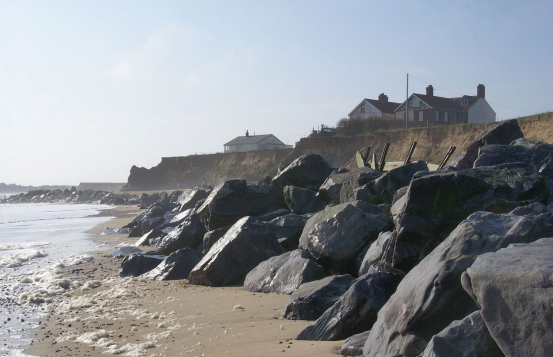
Rock armour pros & cons:
👍Cost effective
👎Rocks are sourced from elsewhere, so don’t fit in with local geology
👎Pose a hazard if climbed on
What are revetments?
Wooden or concrete ramps that help absorb wave energy.
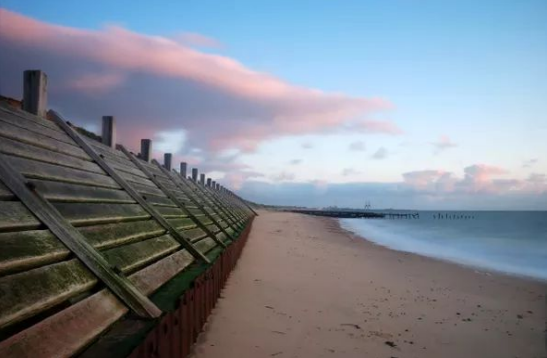
Revetments pros & cons:
👍Cost effective
👎Visually unappealing
👎Can require constant maintenance - additional cost